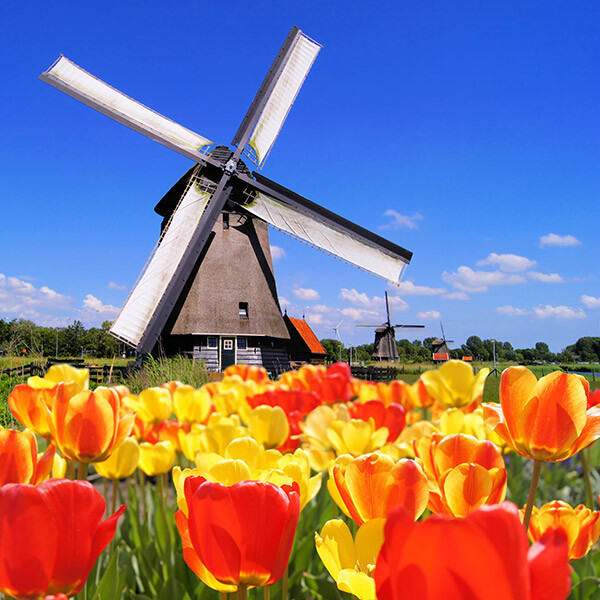
Tulips are a great addition to the garden, as they add colour, vibrancy and structure to any outdoor space – especially as they’re available in an array of different hues, including pinks, purples, reds, crimson, yellow, orange and white.
Regardless of whether they’re planted in pots, containers or in the ground, they’re a green-fingered connoisseurs’ perfect companion!
However, as with all flowers and shrubs, it’s important to follow a few tips and tricks when planting tulips.
7 Tips for Planting Tulips

1. Choosing when and where to plant bulbs
The month of May is the recommended time to plant tulips, as this is when the temperature of the soil is perfect. Although later than most, this planting date can help to reduce the effects of the disease tulip fire. Whether you’ve decided to plant your bulbs in formal or informal beds and borders, containers or even in grass, tulips thrive in fertile, well-drained soil in an area that enjoys full sun throughout various parts of the day. When choosing a position for your tulips, it’s important to select an area that is sheltered from strong winds.
All species of tulip dislike excessively wet conditions; especially alpine species.
Exceptions to this rule include Tulipa sprengeri, Tulipa sylvestris and Tulipa tarda – these particular species prefer partial shade and a more moisture-retentive soil.
2.Deciding on a new home for your bulbs
The likes of a large decorative pot, complete with drainage holes, is the perfect environment for your new bulbs. Before placing soil in the pot, cover the base with gravel. This will prevent the soil from escaping, whilst still allowing for drainage.
There are an abundance of pretty plant pots to choose from, including a variety of sophisticated styles. When choosing a vessel for your tulips, opt for a design that complements your garden. Alternatively, you can plant your bulbs in the ground.
3. Use quality soil
It’s important to fill your chosen container with a rich potting soil. You can find quality soil at your local garden centre – the better the soil, the better chance your tulips have of surviving.
The reason soil quality is so important is because healthy soil is able to store and process more water. Poor quality soil, on the other hand, is unable to hold as much water and therefore, makes it impossible for your new plants to grow, thrive and survive. Healthy, high-quality soil boasts an abundance of organic matter, including living organisms – all of which promote good plant health. When planting tulips, this is an important point to remember as it can define the success of your tulips.
If you can, it’s a good idea to add organic matter to the soil prior to planting tulips, as this will improve both sandy and clay soils, which in turn makes them more suitable. If your soil is lacking in nutrients, simply add chicken manure pellets. Additionally, as a neutral to alkaline soil is the perfect environment for tulips, it’s a good idea to add lime to soil with a pH lower than 6.5.
4. Planting tulips – tips
When planting tulips, always read the instructions on the packaging, as there are many different species of Tulip to choose from, some of which will require slightly different care. In general, the bulb should be planted at a depth that measures two or three times the bulb’s length, and it’s important to plant them between five and 15cm apart with the pointy sides up.
Only use healthy bulbs and remove any that show signs of mould or damage to avoid further problems.
5. What next?
Once you’ve planted your bulbs (following the guidelines on the packet), you must then cover the top of the pot with around 2cm of mulch. The reason behind this is to regulate the soil’s temperature and prevent it from drying out.
6. Give your new bulbs plenty of water
Once you’ve planted your bulbs and covered the top of the soil with mulch, it’s a good idea to give them plenty of water. You should continue to water your bulbs every day or two from the moment they have been planted. However, even though new bulbs require plenty of water, it’s important to avoid over-watering them, as this can cause rot to set in.
7. Encouraging re-flowering
Most species of tulip are best replaced each year, as they’re unlikely to reflower if left in the ground after their first year. Alternatively, you can lift and dry the bulbs post-flowering when the foliage has begun to turn a shade of yellow. Other tips involve deadheading the tulips to prevent seed production.
Once you’ve removed excess soil from the bulbs and allowed them to dry thoroughly, it’s important to discard any that may be diseased or damaged. Store the bulbs in either net bags or trays in a dark, warm and well-ventilated area. The perfect temperature is between 18°C and 20°C.
If you follow these simple tips and look after your bulbs, they will grow into gorgeous flowers! If you’ve enjoyed success when planting tulips and have any other top tips, we’d love to hear from you so that we can share them with everyone. In the meantime, good luck with your growing!